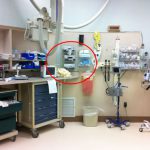The ACS Review Dinner is an important part of gathering information on your trauma program. Many of the principal players in your program are present, and the reviewers will have specific questions for most. Although the reviewers may meet many informally before dinner begins, it may be difficult to keep all the names and titles straight.
Good signs at the table are very helpful. Here are key points on providing the best signage possible:
- The sign must be large. Compare the size of the sign in the photo to the 8.5×11 inch document next to it.
- The font size should be large. This allows the reviewers to read name and title from across the room.
- The same information should be on both sides. Everyone can see their own name so they know where to sit without turning every sign around.
The sign in the photo is a perfect example of what a good placeholder should look like.


